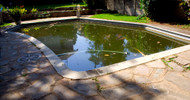Contaminants in Swimming Pools
Posted by Kenton Jones on May 28th 2021
Multipure’s Spotlight for May 2021 is “Water Safety at Home,” which means that this month, our blog posts and social media will focus on ways to keep you and your family safe and healthy around water at home.
When the weather gets hotter and the days get longer, swimming pools of all types become a favorite area for recreation and relaxation at home. While past articles have covered water safety tips for children and parents, this article will focus on contaminants encountered during recreational water activities, e.g., in swimming pools and hot tubs.
Can the Water in Swimming Pools Make You Sick?
The water in swimming pools and hot tubs – whether chlorinated or not – can contain bacteria, viruses, or other contaminants that can cause potential illnesses. These germs enter the water through two main vectors:
- The most common vector is a person entering the water who is ill or otherwise carrying germs into the pool on their body.
- The other main vector is through germs that naturally live in water; when these germ populations grow to high enough levels, they can infect people in the water.
Common symptoms of recreational water illnesses include:
- Diarrhea
- Nausea, vomiting, or stomach cramps
- Skin infections or rashes
- Ear infections
- Eye infections
- Respiratory infections
What Causes Recreational Water Illnesses?
Any time a person with a gastrointestinal illness enters the water, the entire pool of water can become contaminated. Anyone in the water can contract the illness by ingesting even a small amount of contaminated water.

Some of the more common germs (and their effects) associated with recreational water use include:
- Cryptosporidium: acute gastrointestinal illness (AGI)
- Legionella: acute respiratory illness (ARI)
- Pseudomonas: skin and ear infections, ARI
- Norovirus: AGI
- Shigella: AGI
- coli: AGI
- Pool chemicals (chlorine, bromine, hydrochloric acid): ARI, AGI, eye and skin irritation
- Giardia: AGI
- Algae: skin infections, AGI, ARI
What About Chlorinated Pools?
Chlorine is used to disinfect most fixed swimming pools and hot tubs, and is generally effective at treating the presence of harmful bacteria and viruses in the water. But biological and chemical byproducts brought in by people – sweat, dirt, oil, deodorant, and hair gel, for example – can diminish the effectiveness of chlorine to disinfect the water. And many people do not realize that chlorine disinfection is not an instant process, and different germs are treated at different rates.
For example, some general chlorine microbial treatment rates in water are as follows:

- E. coli – less than a minute
- Hepatitis A – about 16 minutes
- Giardia – about 45 minutes
- Cryptosporidium – up to 10 days
This means that there is a gap between the start of chlorination and the safety of the chlorinated water in which harmful microbial life can still infect people. This time period increases if the water is under-chlorinated, but conversely, over-chlorinated water can potentially cause skin or respiratory issues to people in the water.
Doesn’t Chlorine Sanitize the Water from Biological Contaminants?
This is a common misconception. While chlorine does act as a disinfectant against microbial contaminants (given enough time, as mentioned above), human waste, e.g., urine and fecal matter, degrades the ability of the chlorine to treat contaminants. And infants and children are known for having accidents in swimming pools.
Does a Strong Chemical Smell Mean the Water is Properly Chlorinated?
Many people may think that a strong chemical smell around a pool or hot tub means that the water is properly chlorinated and disinfected. Unfortunately, that smell really indicates the opposite. Germs, dirt, skin cells, and other biological contaminants can combine with chlorine to create chloramines. Chloramines can get into the air and create a strong chemical odor that can irritate your nose and eyes. So, in actuality, a powerful chemical odor means that the chlorine in the pool is degraded or depleted.
How Can You Limit Recreational Water Contamination?
It is a good idea to establish rules and best practices when it comes to pools and hot tubs to limit or mitigate possible contamination of the water by the occupants. Some good rules – especially for young children – include:
- Using the bathroom before using a pool or hot tub, and cleaning thoroughly afterward
- Showering for at least 60 seconds before entering a pool or hot tub
- Avoiding shaving or waxing before entering the water (this can prevent skin infections)
- Avoiding any recreational water activities if you have had a gastrointestinal illness within the last two weeks
- Taking frequent stops (at least once each hour) for young children to leave the water and use the bathroom
Other good practices when in the water or right after leaving the water include:

- Keeping water out of your mouth
- Using swimming earplugs or nose clips to limit water exposure to the ear canals and nasal cavity
- Drying your ears after leaving the water
- Blowing your nose after leaving the water
- Showering with soap after leaving the water
Swimming in pools can be a fun and enjoyable activity for people of all ages, especially during the hot summer months. Because of their communal nature, swimming pools can also be a water hazard when it comes to disease and illness, simply due to the presence of other people as potential germ carriers. With some common-sense precautions and practices, recreational water activities can remain as safe as they are enjoyable for all people involved.
References
- “How to Enjoy the Pool Without Getting Sick this Summer.” Healthline. July 2, 2019. https://www.healthline.com/health/swimming-pool-germs-safety
- McCallum, Katie. “Should You Be Worried About Germs in Your Swimming Pool?” Houston Methodist. May 4, 2020. https://www.houstonmethodist.org/blog/articles/2020/may/should-you-be-worried-about-germs-in-your-swimming-pool/
- “Recreational Water Illnesses.” Centers for Disease Control and Prevention. June 4, 2020. https://www.cdc.gov/healthywater/swimming/swimmers/rwi.html
- Ryan, Una. “What’s In Your Swimming Pool?” Australian Academy of Science. November 29, 2016. https://www.science.org.au/curious/everything-else/swimming-pool

